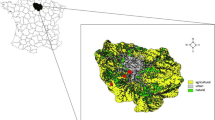Abstract
The red fox (Vulpes vulpes) is generally considered a pest species, especially in rural habitats where it is perceived as a predator of livestock and game species. In many countries, population-control programs are carried out to prevent predation on species of human concern. However, most of these programs occur without an analysis of the real fox impact. This study analyzed the diet of red foxes inhabiting a farmland area characterized by the presence of both free-ranging livestock and game species. We analyzed a total of 147 scats belonging to 32 food samples. Invertebrates represented the main food category (recorded on 66% of food samples), followed by fruit and small mammals, both recorded on 59% of food samples. The seasonal variation of the diet matched the availability of food resources, as demonstrated by the outcome of small mammal trapping activity in the area. The livestock consumption regarded almost exclusively carrions, since only hair of adult sheep were recorded with high frequency. Wild boar hair were found in two food samples, lamb and hare hair were found in only one. Our study showed an easy protocol to assess the role of red fox as a predator of livestock and game species before planning management actions. In the analyzed farmland, for instance, a population-control program should not be justified despite the presence of lambs, piglets, hares and pheasants.
Similar content being viewed by others
References
Baker, P.J. and Harris S., Does culling reduce fox (Vulpes vulpes) density in commercial forests in Wales, UK?, Eur. J. Wildl. Res., 2006, vol. 52, pp. 99–108.
Cavallini, P. and Lovari, S., Environmental factors influencing the use of habitat in red fox, Vulpes vulpes, J. Zool. (London), 1991, vol. 223, pp. 323–339.
Ciucci, P., Boitani, L., Raganella Pelliccioni, E., Rocco, M., and Guj, I., A comparison of scat-analysis methods to assess the diet of the wolf Canis lupus, Wildl. Biol., 1996, vol. 2, pp. 37–48.
Dell’Arte, G.L., Laaksonen, T., Norrdahl, K., and Korpimaki, E., Variation in the diet composition of a generalist predator, the red fox, in relation to season and density of main prey, Acta Oecol., 2007, vol. 31, pp. 276–281.
De Marinis, A.M. and Agnelli, P., Guide to the microscope analysis of Italian mammals hairs: Insectivora, Rodentia, and Lagomorpha, Ital. J. Zool., 1993, vol. 60, pp. 225–232.
Gentle, M.N., Saunders, G.R., and Dickman, C.R., Poisoning for production: How effective is fox baiting in south-eastern Australia, Mammal. Rev., 2007, vol. 37, pp. 177–190.
Harding, E.K., Doak, D.F., and Albertson, J.D., Evaluating the effectiveness of predator control: The nonnative red fox as a case study, Conserv. Biol., 2001, vol. 15, pp. 1114–1122.
Heydon, M.J. and Reynolds, J.C., Fox (Vulpes vulpes) management in three contrasting regions of Britain, in relation to agricultural and sporting interests, J. Zool. (London), 2000, vol. 251, pp. 237–252.
Lincoln, F.C., Calculating waterfowl abundance on the basis of banding returns, United States Department of Agriculture Circular, 1930, vol. 118, pp. 1–4.
Moberly, R.L., White, P.C.L., Webbon, C.C., Baker, P.J., and Harris, S., Factors associated with fox (Vulpes vulpes) predation of lambs in Britain, Wildl. Res., 2003, vol. 30, pp. 219–227.
Moberly, R.L., White, P.C.L., Webbon, C.C., Baker, P.J., and Harris, S., Modeling the costs of fox predation and preventative measures on sheep farms in Britain, J. Environ. Manag., 2004, vol. 70, pp. 129–143.
Panek, M. and Bresinski, W., Red fox density and habitat use in a rural area of western Poland in the end of 1990s, compared with the turn of 1970s, Acta. Theriol., 2002, vol. 47, pp. 433–442.
Saunders, G. and McLeod, L., Improving Fox Management Strategies in Australia, Canberra: Bureau of Rural Sciences, 2007.
Sidorovic, V.E., Sidorovic, A.A., and Izotova, I.V., Variation in the diet and population density of the red fox Vulpes vulpes in the mixed woodlands of northern Belarus, Mammal. Biol., 2006, vol. 71, pp. 74–89.
Slade, N.A. and Blair, S.M., An empirical test of using counts of individuals captured as indices of populations sizes, J. Mammal., 2000, vol. 81, pp. 1423–1435.
Teerink, B.J., Hair of West European Mammals: Atlas and Identification Key, Cambridge, UK: Cambridge Univ. Press, 2004.
Wolff, J.O., Population fluctuations of mast-eating rodents are correlated with production of acorns, J. Mammal., 1996, vol. 77, pp. 859–856.
Author information
Authors and Affiliations
Corresponding author
Additional information
The article is published in the original.
Rights and permissions
About this article
Cite this article
Cecere, J.G., Benedetti, M.C., Guj, I. et al. The role of the red fox as a predator of species of human concern in a mediterranean rural habitat: A case Study. Russ J Ecol 45, 555–558 (2014). https://doi.org/10.1134/S106741361406006X
Received:
Published:
Issue Date:
DOI: https://doi.org/10.1134/S106741361406006X



